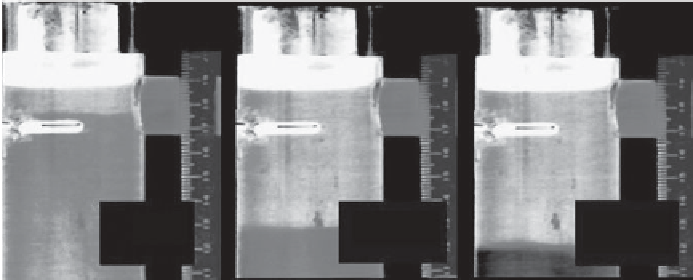Geoscience Reference
In-Depth Information
(a)
(b)
Hysteresis
Salt mode
Temperature mode
Temperature mode
Salt mode
0.2
0.6
0.1
0.5
0
0.4
-0.1
-0.2
0.3
-0.3
0.2
-0.4
0.1
-0.5
0
-0.6
-0.1
-0.7
0
0.2
0.4
0.
6
0.8
1
1.2
1.4
0.55 0.6 0.65 0.7 0.7
5
0.8 0.85 0.9 0.95
1
T
*
T
*
Figure 13.5.
Density from (a) the box experiment and (b) the cavity experiment.
(a)
(b)
(c)
0s
12,831s
16,329s
Figure 13.6.
The oscillation cycle. (a) formation of a dyed freshwater layer over a very deep mixed layer of dyed salty water and
clear salty water; (b) deepening of the top layer; (c) overturn and mixing of the deeper layer resulting in clear salt water lying
below the top layer. Thereafter, a new fresh layer forms at the top as in (a). The previous top layer becomes the deep mixed layer,
and the cycle repeats. [From
Whitehead et al.
, 2005].
experiment, so their existence is only mentioned briefly
at the end of section 4.2 by
Whitehead et al.
[2003]. The
next observations of oscillations were unexpectedly dis-
covered in an early exploratory upside-down version of
the layered experiment and were both robust and repro-
ducible. The apparatus had a chamber heated from below
with a layer of salty water flowing in along the bot-
tom of a tank containing fresh water. The results are
reported in a Geophysical Fluid Dynamics Fellow's report
[
teRaa
, 2001]. This led to the development of the lay-
ered apparatus. The oscillations and their properties are
documented more fully, and a supporting theory is devel-
oped in
Whitehead et al.
[2005]. This work was followed by
oscillations reported by
Mullarney et al.
[2007]. They were
unaware of the previous observations of oscillations. As
in the te Raa apparatus, a layer of salt water flows over a
hot plate on the bottom of a chamber of fresh water, but
the apparatus is more than ten times larger.
The oscillation process in all of these experiments is the
same, and it is very simple. In the layered apparatus, a layer
of dyed freshwater forms at the top (Figure 13.6a). The
interface at the base of this layer begins to move down-
ward and the layer becomes much deeper (Figure13.6b).
Below this is a deeper older layer. The color of the deeper
layer begins to fade dramatically as the freshwater source
to this layer has been blocked by the new top layer. After
some time, the interface between the old layer and the bot-
tom salt water develops large waves that begin to break.
Mixing between this deep layer and bottom salt water
increases and the color difference between the lower layer






















































































































































































